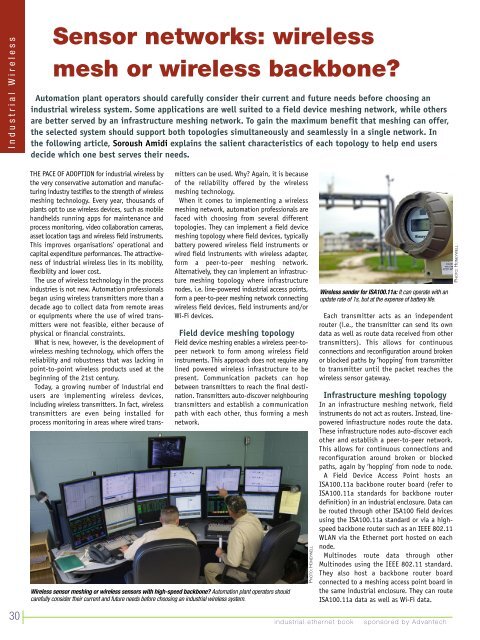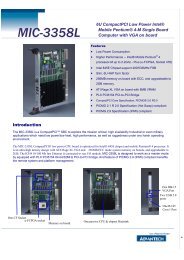industrial wireless book special edition - Networking ...
industrial wireless book special edition - Networking ...
industrial wireless book special edition - Networking ...
Create successful ePaper yourself
Turn your PDF publications into a flip-book with our unique Google optimized e-Paper software.
I n d u s t r i a l W i r e l e s s<br />
30<br />
Sensor networks: <strong>wireless</strong><br />
mesh or <strong>wireless</strong> backbone?<br />
Automation plant operators should carefully consider their current and future needs before choosing an<br />
<strong>industrial</strong> <strong>wireless</strong> system. Some applications are well suited to a field device meshing network, while others<br />
are better served by an infrastructure meshing network. To gain the maximum benefit that meshing can offer,<br />
the selected system should support both topologies simultaneously and seamlessly in a single network. In<br />
the following article, Soroush Amidi explains the salient characteristics of each topology to help end users<br />
decide which one best serves their needs.<br />
THE PACE OF ADOPTION for <strong>industrial</strong> <strong>wireless</strong> by<br />
the very conservative automation and manufacturing<br />
industry testifies to the strength of <strong>wireless</strong><br />
meshing technology. Every year, thousands of<br />
plants opt to use <strong>wireless</strong> devices, such as mobile<br />
handhelds running apps for maintenance and<br />
process monitoring, video collaboration cameras,<br />
asset location tags and <strong>wireless</strong> field instruments.<br />
This improves organisations’ operational and<br />
capital expenditure performances. The attractiveness<br />
of <strong>industrial</strong> <strong>wireless</strong> lies in its mobility,<br />
flexibility and lower cost.<br />
The use of <strong>wireless</strong> technology in the process<br />
industries is not new. Automation professionals<br />
began using <strong>wireless</strong> transmitters more than a<br />
decade ago to collect data from remote areas<br />
or equipments where the use of wired transmitters<br />
were not feasible, either because of<br />
physical or financial constraints.<br />
What is new, however, is the development of<br />
<strong>wireless</strong> meshing technology, which offers the<br />
reliability and robustness that was lacking in<br />
point-to-point <strong>wireless</strong> products used at the<br />
beginning of the 21st century.<br />
Today, a growing number of <strong>industrial</strong> end<br />
users are implementing <strong>wireless</strong> devices,<br />
including <strong>wireless</strong> transmitters. In fact, <strong>wireless</strong><br />
transmitters are even being installed for<br />
process monitoring in areas where wired transmitters<br />
can be used. Why? Again, it is because<br />
of the reliability offered by the <strong>wireless</strong><br />
meshing technology.<br />
When it comes to implementing a <strong>wireless</strong><br />
meshing network, automation professionals are<br />
faced with choosing from several different<br />
topologies. They can implement a field device<br />
meshing topology where field devices, typically<br />
battery powered <strong>wireless</strong> field instruments or<br />
wired field instruments with <strong>wireless</strong> adapter,<br />
form a peer-to-peer meshing network.<br />
Alternatively, they can implement an infrastructure<br />
meshing topology where infrastructure<br />
nodes, i.e. line-powered <strong>industrial</strong> access points,<br />
form a peer-to-peer meshing network connecting<br />
<strong>wireless</strong> field devices, field instruments and/or<br />
Wi-Fi devices.<br />
Field device meshing topology<br />
Field device meshing enables a <strong>wireless</strong> peer-topeer<br />
network to form among <strong>wireless</strong> field<br />
instruments. This approach does not require any<br />
lined powered <strong>wireless</strong> infrastructure to be<br />
present. Communication packets can hop<br />
between transmitters to reach the final destination.<br />
Transmitters auto-discover neighbouring<br />
transmitters and establish a communication<br />
path with each other, thus forming a mesh<br />
network.<br />
Wireless sensor meshing or <strong>wireless</strong> sensors with high-speed backbone? Automation plant operators should<br />
carefully consider their current and future needs before choosing an <strong>industrial</strong> <strong>wireless</strong> system.<br />
PHOTO: HONEYWELL<br />
<strong>industrial</strong> ethernet <strong>book</strong><br />
Wireless sender for ISA100.11a: It can operate with an<br />
update rate of 1s, but at the expense of battery life.<br />
Each transmitter acts as an independent<br />
router (i.e., the transmitter can send its own<br />
data as well as route data received from other<br />
transmitters). This allows for continuous<br />
connections and reconfiguration around broken<br />
or blocked paths by ‘hopping’ from transmitter<br />
to transmitter until the packet reaches the<br />
<strong>wireless</strong> sensor gateway.<br />
Infrastructure meshing topology<br />
In an infrastructure meshing network, field<br />
instruments do not act as routers. Instead, linepowered<br />
infrastructure nodes route the data.<br />
These infrastructure nodes auto-discover each<br />
other and establish a peer-to-peer network.<br />
This allows for continuous connections and<br />
reconfiguration around broken or blocked<br />
paths, again by ‘hopping’ from node to node.<br />
A Field Device Access Point hosts an<br />
ISA100.11a backbone router board (refer to<br />
ISA100.11a standards for backbone router<br />
definition) in an <strong>industrial</strong> enclosure. Data can<br />
be routed through other ISA100 field devices<br />
using the ISA100.11a standard or via a highspeed<br />
backbone router such as an IEEE 802.11<br />
WLAN via the Ethernet port hosted on each<br />
node.<br />
Multinodes route data through other<br />
Multinodes using the IEEE 802.11 standard.<br />
They also host a backbone router board<br />
connected to a meshing access point board in<br />
the same <strong>industrial</strong> enclosure. They can route<br />
ISA100.11a data as well as Wi-Fi data.<br />
sponsored by Advantech<br />
PHOTO: HONEYWELL

















